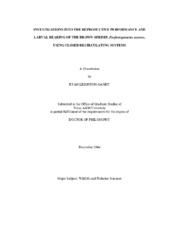| dc.contributor.advisor | Masser, Michael P. | |
| dc.contributor.advisor | Samocha, Tzachi M. | |
| dc.creator | Gandy, Ryan Leighton | |
| dc.date.accessioned | 2005-02-17T21:05:59Z | |
| dc.date.available | 2005-02-17T21:05:59Z | |
| dc.date.created | 2004-12 | |
| dc.date.issued | 2005-02-17 | |
| dc.identifier.uri | https://hdl.handle.net/1969.1/1573 | |
| dc.description.abstract | The effects of unilateral eyestalk ablation, diets and sex ratios were evaluated on two wild populations of Farfantepenaeus aztecus in a closed recirculating maturation system. Ovarian development and spawning frequencies of ablated females in both studies were higher than the non-ablated females. Replacement of bloodworms in maturation diet with enriched adult Artemia sp. had no negative effect on the number of eggs spawned and resulted in increased hatch and survival rates from Nauplius I to Zoea I. Life span of ablated females fed enriched Artemia sp. was longer than ablated females fed bloodworms. Replacement of the expensive bloodworm diet component with adult enriched Artemia sp. is possible without negative impact on female reproductive performance. Reducing male to female ratio from 2:1 to 1:1 resulted in a 1.25% decrease in spawning activities of ablated females. The life cycle of pond-raised F1 generation F. aztecus also was completed in the closed recirculating system using unilateral eyestalk ablation as previously described. This study found diets that
contained an enriched adult Artemia sp. component performed superior (i.e. hatch rate, nauplii and zoea production) to a diet containing bloodworms. Six consecutive larval rearing trials evaluated changes in select water quality indicators and their effect on growth, survival, and stress tolerance of F. aztecus postlarvae cultured in artificial seawater under closed recirculating and flow-through conditions. The closed recirculating larval rearing system successfully produced five-day-old postlarvae (PL) from Zoea I (Z1) with similar dry weights, lengths and stress resistance to PL produced under standard water exchange practices. The trickling biofilters were found to be a limiting component of this system. A submerged coral biofilter was added to the system and effectively processed culture water for re-use. Addition of the submerged biofilter resulted in improved survival rates in Trials 4, 5 and 6. These studies demonstrate maturation and larval rearing of F. aztecus is feasible in closed recirculating systems. Implementation of these systems in hatcheries bolsters biosecurity while reducing the environmental impact of hatchery effluent. Recirculating and re-use systems are therefore essential in the further development of sustainable hatchery programs for endemic species. | en |
| dc.format.extent | 1575142 bytes | en |
| dc.format.medium | electronic | en |
| dc.format.mimetype | application/pdf | |
| dc.language.iso | en_US | |
| dc.publisher | Texas A&M University | |
| dc.subject | Maturation | en |
| dc.subject | Larval Rearing | en |
| dc.subject | Closed Recirculation | en |
| dc.subject | Brown Shrimp | en |
| dc.subject | Farfantepenaeus aztecus | en |
| dc.subject | bait shrimp | en |
| dc.subject | life cycle | en |
| dc.title | Investigations into the reproductive performance and larval rearing of the Brown shrimp, Farfantepenaeus aztecus, using closed recirculating systems | en |
| dc.type | Book | en |
| dc.type | Thesis | en |
| thesis.degree.department | Wildlife and Fisheries Sciences | en |
| thesis.degree.discipline | Wildlife and Fisheries Sciences | en |
| thesis.degree.grantor | Texas A&M University | en |
| thesis.degree.name | Doctor of Philosophy | en |
| thesis.degree.level | Doctoral | en |
| dc.contributor.committeeMember | Ali, Abdul-Mehdi S. | |
| dc.contributor.committeeMember | Gatlin, Delbert M., III | |
| dc.contributor.committeeMember | Speed, F. Michael | |
| dc.contributor.committeeMember | Fox, Joe M. | |
| dc.type.genre | Electronic Dissertation | en |
| dc.type.material | text | en |
| dc.format.digitalOrigin | born digital | en |


